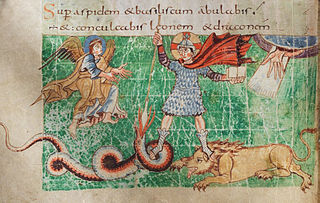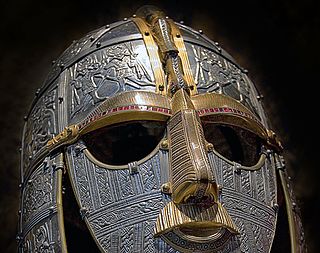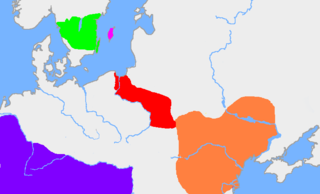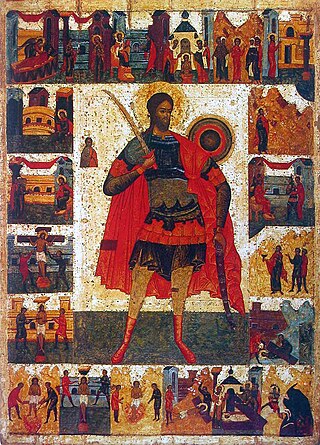The Goths were a Germanic people who played a major role in the fall of the Western Roman Empire and the emergence of medieval Europe. They were first reported by Graeco-Roman authors in the 3rd century AD, living north of the Danube in what is now Ukraine, Moldova, and Romania. From here they conducted raids into Roman territory, and large numbers of them joined the Roman military. These early Goths lived in the regions where archaeologists find the Chernyakhov culture, which flourished throughout this region during the 3rd and 4th centuries.

The Ostrogoths were a Roman-era Germanic people. In the 5th century, they followed the Visigoths in creating one of the two great Gothic kingdoms within the Western Roman Empire, drawing upon the large Gothic populations who had settled in the Balkans in the 4th century. While the Visigoths had formed under the leadership of Alaric I, the new Ostrogothic political entity which came to rule Italy was formed in the Balkans under Theodoric the Great.

Týr is a god in Germanic mythology and member of the Æsir. In Norse mythology, which provides most of the surviving narratives about gods among the Germanic peoples, Týr sacrifices his right hand to the monstrous wolf Fenrir, who bites it off when he realizes the gods have bound him. Týr is foretold of being consumed by the similarly monstrous dog Garmr during the events of Ragnarök.

The Visigoths were a Germanic people united under the rule of a king and living within the Roman Empire during late antiquity. The Visigoths first appeared in the Balkans, as a Roman-allied barbarian military group united under the command of Alaric I. Their exact origins are believed to have been diverse but they probably included many descendants of the Thervingi who had moved into the Roman Empire beginning in 376 and had played a major role in defeating the Romans at the Battle of Adrianople in 378. Relations between the Romans and Alaric's Visigoths varied, with the two groups making treaties when convenient, and warring with one another when not. Under Alaric, the Visigoths invaded Italy and sacked Rome in August 410.

Slavic paganism, Slavic mythology, or Slavic religion is the religious beliefs, myths, and ritual practices of the Slavs before Christianisation, which occurred at various stages between the 8th and the 13th century.

Old Norse religion, also known as Norse paganism, is a branch of Germanic religion which developed during the Proto-Norse period, when the North Germanic peoples separated into a distinct branch of the Germanic peoples. It was replaced by Christianity and forgotten during the Christianisation of Scandinavia. Scholars reconstruct aspects of North Germanic Religion by historical linguistics, archaeology, toponymy, and records left by North Germanic peoples, such as runic inscriptions in the Younger Futhark, a distinctly North Germanic extension of the runic alphabet. Numerous Old Norse works dated to the 13th-century record Norse mythology, a component of North Germanic religion.

The Germanic peoples underwent gradual Christianization in the course of late antiquity and the Early Middle Ages. By CE 700, England and Francia were officially Christian, and by 1100 Germanic paganism had also ceased to have political influence in Scandinavia.

Germanic paganism or Germanic religion refers to the traditional, culturally significant religion of the Germanic peoples. With a chronological range of at least one thousand years in an area covering Scandinavia, the British Isles, modern Germany, the Netherlands, and at times other parts of Europe, the beliefs and practices of Germanic paganism varied. Scholars typically assume some degree of continuity between Roman-era beliefs and those found in Norse paganism, as well as between Germanic religion and reconstructed Indo-European religion and post-conversion folklore, though the precise degree and details of this continuity are subjects of debate. Germanic religion was influenced by neighboring cultures, including that of the Celts, the Romans, and, later, by the Christian religion. Very few sources exist that were written by pagan adherents themselves; instead, most were written by outsiders and can thus present problems for reconstructing authentic Germanic beliefs and practices.
Gaut is an early Germanic name, from a Proto-Germanic gautaz, which represents a mythical ancestor or national god in the origin myth of the Geats.
The Amali – also called Amals, Amalings or Amalungs – were a leading dynasty of the Goths, a Germanic people who confronted the Roman Empire during the decline of the Western Roman Empire. They eventually became the royal house of the Ostrogoths and founded the Ostrogothic Kingdom.

Anglo-Saxon paganism, sometimes termed Anglo-Saxon heathenism, Anglo-Saxon pre-Christian religion, Anglo-Saxon traditional religion, or Anglo-Saxon polytheism refers to the religious beliefs and practices followed by the Anglo-Saxons between the 5th and 8th centuries AD, during the initial period of Early Medieval England. A variant of Germanic paganism found across much of north-western Europe, it encompassed a heterogeneous variety of beliefs and cultic practices, with much regional variation.
Gothic Christianity refers to the Christian religion of the Goths and sometimes the Gepids, Vandals, and Burgundians, who may have used the translation of the Bible into the Gothic language and shared common doctrines and practices.

Sabbas the Goth was a Christian martyr venerated as a saint.
The Thervingi, Tervingi, or Teruingi were a Gothic people of the plains north of the Lower Danube and west of the Dniester River in the 3rd and the 4th centuries.

The Greuthungi were a Gothic people who lived on the Pontic steppe between the Dniester and Don rivers in what is now Ukraine, in the 3rd and the 4th centuries. They had close contacts with the Tervingi, another Gothic people, who lived west of the Dniester River. To the east of the Greuthungi, living near the Don river, were the Alans.
The pagan religion of the Germanic tribal confederation of the Franks has been traced from its roots in polytheistic Germanic paganism through to the incorporation of Greco-Roman components in the Early Middle Ages. This religion flourished among the Franks until the conversion of the Merovingian king Clovis I to Nicene Christianity, though there were many Frankish Christians before that. After Clovis I, Frankish paganism was gradually replaced by the process of Christianisation, but there were still pagans in the late 7th century.

There is a record of Gothic persecution of Christians in the third century. According to Basil of Caesarea, some prisoners taken captive in a Gothic raid on Cappadocia around 260 preached the gospel to their captors and were martyred. One of their names was Eutychus. Bishop Dionysius of Caesarea sent messengers to the Goths to ransom captives and there was still a written record of these attempts in Basil's time.
Reiks is a Gothic title for a tribal ruler, often translated as "king".

The name of the Goths is one of the most discussed topics in Germanic philology. It is first recorded by Greco-Roman writers in the 3rd century AD, although names that are probably related appear earlier. Derived from Proto-Germanic *Gutōz ~ *Gutaniz, it is closely related to and probably means the same as the names of both the Geats of southern Sweden and Gutes of Gotland. The implications of these similarities, and the actual meaning of the Gothic name, are disputed in scholarship.

Haliurunas, haljarunae, Haliurunnas, haliurunnae, etc., were Gothic "witches" who appear once in Getica, a 6th century work on Gothic history. The account tells that the early Goth king Filimer found witches among his people when they had settled north of the Black Sea, and that he banished them to exile. They were impregnated by unclean spirits and engendered the Huns, and the account is a precursor of later Christian traditions where wise women were alleged to have sexual intercourse and even orgies with demons and the Devil.

![A drawing of the Elder Futhark inscription from the Ring of Pietroassa (3rd or 4th century), read as gutaniowi hailag (gutani[o]wi hailag). The seventh letter, here substituted as o (o), was destroyed when the ring was cut in half by thieves in 1875. The reading of the damaged part is disputed, but it is clear that the inscription begins with the name of the Goths (Gutani) and ends with the word for "holy, sacred" (hailag). Pietroassa Inschrift.jpg](http://upload.wikimedia.org/wikipedia/commons/thumb/6/69/Pietroassa_Inschrift.jpg/250px-Pietroassa_Inschrift.jpg)












